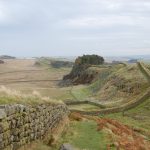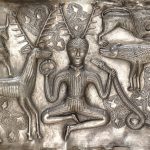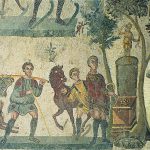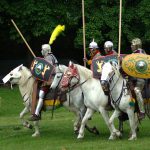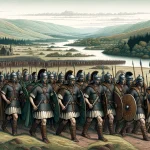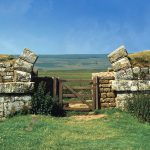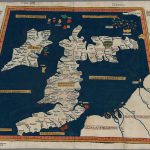Hadrian's Wall - Fort - Great Chesters (Aesica)
Cemetery, Hadrian's Wall Fort and Vicus
This small infantry fort has its long axis directed along the line of the wall facing east to guard the Caw Gap, like the fort at Housesteads in relation to the Knag Burn further east, although Vercovicium is much larger than the Great Chesters fort which covers an area of only about 3 acres (c.1.2 ha). The siting of a garrison on the Wall here was obviously an afterthought, for under the north-west corner of the fort lie the footings of Mile-Castle 43, which had to be levelled in order to accommodate the fort’s interior buildings.
The site is notable in that the ‘broad wall’ foundations were laid-down before it was decided to build the Wall here in a narrower gauge, but, unlike elsewhere, the ‘narrow wall’ at Great Chesters was constructed on new footings immediately behind the broad foundations, which were perhaps prepared the previous season. The narrow wall was later to form the northern defences of the Aesica fort.
The defences are notable in that there are four external ditches on the western side of the fort, whereas the southern and eastern sides were served by only a single ditch; this suggests that the builders of the fort were concerned by the flat approach from the west. On the southern side, it appears that the outer defences interfere with the structure of the Vallum, which was evidently already in place when the fort was built.
RIB 1736 - Inscription
For the Emperor Caesar Trajan Hadrian Augustus, father of his country.
NO AVG P P
No other letters have occupied the die. For, instead of cutting an inscription in large letters, the mason has chosen to place two lines of smaller lettering in the position where they would best be seen on a tablet high up over the gate R.P.W.Hadrian received the title pater patriae in A.D. 128. Stevens dates the construction of the fort probably to a.d. 129. Addenda from RIB+add. (1995): Bennett notes some instances of Hadrian pater patriae before a.d. 128 (Brit. xv (1984), 234-5), but they remain exceptional.
The fort was excavated in 1897 and a number of the interior buildings were uncovered; most of the principia (headquarters building), the praetorium (commanding officer’s house), a horraeum (grain-store), and some of the centuriae (barrack-blocks). The west gate is of particular note, as it shows evidence of successive narrowings of the gateway during the entire period of occupation, until it was eventually blocked off completely. The eastern gate-house yielded an inscription which proves that the fort was built during the latter reign of Hadrian (vide supra), while another inscription tells us that the building work was possibly undertaken by the men of Legio XX Valeria Victrix, who were stationed at Chester during the winter months, but each summer during the reign of Hadrian at least, would be found working on the entrenchments and fortifications of the Wall (vide infra).
RIB 1748 - Inscription
48
No commentary.
There are thirty-one inscribed stones recorded in the R.I.B. for Great Chesters, comprising; eleven altarstones and a statue base dedicated to various gods, six building inscriptions (only three dateable), seven tombstones and six other undefined stones including the distance marker XLVIII “Forty-eight” (RIB 1748) which recorded the building of a length of rampart wall.
The Garrison Units
RIB 1725 - Altar dedicated to Jupiter Optimus Maximus of Doliche
To Jupiter, Best and Greatest, of Dolic(h)e, Lucius Maximius Gaetulicus, centurion of the Twentieth Legion Valeria Victrix, willingly and deservedly fulfilled his vow.
D[...]ICENO LV
CIVS MAXIM
IVS GAETVLIC
VS 𐆛 LEG XX V V
V [ ] M
For the same centurion see RIB 2120 (Newstead). Addenda from RIB+add. (1995): For the same centurion, see also AE 1985, 735 (Novae), the altar dedicated by him in A.D. 184 as primus pilus of Legion I Italica, in fulfilment of the vow he had made when he enlisted with Legion XX Valeria Victrix 57 years before. His full name and origin are L. Maximius L. f. Voltiniae Gaetulicus Viennae.
RIB 1746 - Funerary inscription for Nigrina
Sacred to the spirits of the departed (and) to Nigrina, (who) lived 40 years: Aurelius Casitto, centurion of the Sixth Legion Victrix Pia Fidelis, had this set up.
NIGṚI
ṆAE V[...]X A XXXX
[...]VR CASITṬO
𐆛 L[...]G [...]
P F C[...]
No commentary.
RIB 1727 - Altar dedicated to Jupiter Optimus Maximus
To Jupiter, Best and Greatest, … of Gauls ..
[...]
[...]N[..]
No commentary.
RIB 1731 - Dedication to the Emperor's Victory
To the Emperor’s Victory the Sixth Cohort of Nervians, commanded by Gaius Julius Barbarus, the prefect, willingly and deservedly fulfilled its vow.
NERVIORVM CVI PRAEEST G
IVL BARBARVS PRAEFEC V S L L M
No commentary.
The early second century garrison was Cohors VI Nerviorum, a five-hundred strong infantry unit from the region of modern Belgium, who are attested on an inscription found in the Headquarters building in the centre of the fort. This unit was removed in the late second century and posted to Rough Castle on the The Antonine Wall in Scotland.
RIB 1737 - Dedication-slab
For the Emperor-Caesars Antoninus and Verus, both Augusti, conquerors of Parthia, Media, and Armenia, the Sixth (?) Cohort of Raetians ..
[...]THICIS MEDICIS [...]
[... ]I RAETORV[ ...]
[...]MISIA [..]CCI [..] ET [...]
[...]IIAT[...]
No commentary.
RIB 1724 - Altar dedicated to Fortune
To the goddess Fortune the detachment of the Raetian Spearmen, under the command of Tabellius Victor, centurion, (set this up).
VEXS G RETO
QVORVM CVR
AM AGIT TABE
LLIVS VICTOR
𐆛
For the Raeti Gaesati see RIB 1216, 1217, 1235 (Risingham) and 2117 (site near Jedburgh).
RIB 1667 - Funerary inscription for Dagvalda
Sacred to the spirits of the departed: Dagvalda, soldier in the First Cohort of Pannonians, lived [] years his wife Pusinna set up this tombstone.
DAGVALDA M[...]Ḷ [... ]
PAN VIXIT AN [...]
PVSINNA [...]
[...]X TITVLṾ[ ...]
Clayton suggested that this tombstone may have been brought from the burial-ground of the fort of Great Chesters, which overlies the site of milecastle no. 43.Birley (Cumb. Westm. AAST 2nd Ser. xxxix (1939) 216) dates this text ‘late in the second century at earliest’ and assigns it to coh. I Pan., noting that this tombstone of a soldier need not prove the presence of the regiment.Scherer, Corolla (1955) 206 cites Dagvalda as a compound of Celtic and German words for ‘good ruler’. For Pusinna cf. CIL xiii 5156. Also cf. RIB 612, 1829.
It is possible that Cohors I Pannoniorum were stationed at Greatchesters sometime during its early history, as a tombstone belonging to a soldier of this unit was found in Mile-Castle 42 nearby (vide RIB 1667). The tombstone had been cut into a rough circular shape and was being used by the soldiers in the Mile Castle as a hearth stone. The inscription is missing the numeral associated with the unit, but the First Pannonian Cohort is assumed.
RIB 1738 - Dedication-slab to Severus Alexander
The Emperor Caesar Marcus Aurelius Severus Alexander Pius Felix Augustus for the soldiers of the Second Cohort of Asturians, styled Severus Alexander’s, restored from ground-level this granary fallen in through age, while the province was governed by … Maximus, emperor’s propraetorian legate, under the charge of Valerius Martialis, centurion of the … Legion, in the consulship of Fuscus for the second time and Dexter.
RVS ALEXANDER P FEL
AVG HORREVM VETV
STATE CONLABSVM MIL COH II ASTVRVM S A
A SOLO RESTITVERVNT
PROVINCIA REGENTE [...]
MAXIMO LEG [...]
VAL MARTIA[...]
[...]VS[...]
No commentary.
During the third century the garrison unit was Cohors II Asturum Equitata, a five-hundred strong mixed unit of cavalry and infantry, from the Astures tribe of Northen Spain. Their presence is recorded on a building inscription claiming credit for rebuilding the granary in the fort. The unit is also mentioned as the garrison of Aesica in the The Notitia Dignitatum, but recorded with the numeral I (primae), which is probably an error.
The Notitia Dignitatum Entry
RIB 1723 - Fragmentary dedication
To the Discipline ..
Wrongly assigned to Vindolanda by Watkin and Huebner.
RIB 1726 - Altar dedicated to Jupiter Optimus Maximus of Doliche
To Jupiter, Best and Greatest, of Doliche, … Regulus, son of Sabinus, of the […]ina voting-tribe … (set this up).
[...] SABINI FIL
[...]INA REGVLVS
[...] PVBLI[...]
On the capital is a small altar confronted by an animal. Hettner regards it as a doe, sacred to Juno, and not as a bull (see Huebner) as bulls are represented facing right. Macdonald (PSAS lxvi (1931-2) 276) says that it has been regarded as a cow, which seems more likely R.P.W.
Three Altarstones to the Germanic Warrior Triad Vheterus
The Vicus and Bath House
The civil settlement or vicus occupied the area to the immediate south and west of the fort. A burial ground has been identified about ¼ mile (0.4km) along the road south to the Stanegate. Excavations here revealed a hoard of jewellery dated on stylistic grounds to the third-century and including a gilded bronze brooch, a silver collar pendant and a gold ring. Replicas of these objects are on display in the Museum of Antiquities in Newcastle.
RIB 1742 - Funerary inscription for Aelius Mercurialis
To the spirits of the departed (and) to Aelius Mercurialis, cornicularius, his sister Vacia set this up.
AEL MERCV
RIALI CORNICVL
VACIA SOROR FECIT
No commentary. Addenda from RIB+add. (1995): cornicularius: see the Glossary.
Some More Greatchesters Tombstones
RIB 1743 - Funerary inscription for Lucius Novellius Lanuccus
To the spirits of the departed: Lucius Novellius Lanuccus, Roman citizen, aged 70. His daughter Novellia Justina had this set up.
L · NOVEÍ¡L▸L LAN
VCCVS · C · R · AN LX͡X
NOVEÍ¡L IVSTINA
FIL
[...] C
No commentary. Addenda from RIB+add. (1995): See further CSIR i, 6. 215. With the exception of RIB 1420 and two stones from Stanwix (RIB 2029 and 2030), this is the only tombstone from a Wall fort to bear the (almost) unabbreviated Dis Manibus formula. The explicit reference to Roman citizenship also implies an early date. Note the distinctive ligature of e and l, which also occurs in RIB 894 (A.D. 191), 1060 (A.D. 222) and 929 (A.D. 225/35), an argument for caution in dating by letter-form alone.
RIB 1747 - Funerary inscription for Pervica
To the spirits of the departed (and) to his daughter Pervica ..
PERVICAE FILIAE
[...]
Pennant wrongly assigns this to Hoddom Castle. Addenda from RIB+add. (1995): Pennant distinguishes this from an otherwise unknown inscription at Hoddom Castle [i.e. from Birrens] inscribed Dis Manibus Sacrum JULIA PERVICAE Filiae, which E. Birley (Dumfriess. and Gall. NHAST xxxviii, 145-6, No. 12) interprets as the lost tombstone of one Iulia Pervicae fil(ia). But it is clear from the drawing of RIB 1747 (photographed as CSIR i, 6. 216) that Pennant mis-read 1, dis m as d m s ivl. Except for RIB 1620 (Pervinca), the name Pervica is unique.
RIB 1745 - Funerary inscription for Aurelia Caula
To the spirits of the departed (and) to Aurelia Caula: Aurelia S[…]illa (set this up) to her very dear sister (who) lived 15 years, 4 months.
AVRELIAE
CAVLA[...]
AVR[...]LIA
S[...]ILLA
[...]ORORI [...]
RISSIME
VIXIT AN
XV MS IIII
No commentary.
The Greatchesters Bath-house
There is a bath-house situated about one hundred yards to the south-east of the fort which was supplied with water via an aqueduct from the headwaters of Caw Burn just over two miles distant from the fort. The aqueduct is in the form of a shallow channel, which winds a tortuous path for over six miles following the contours of the land. The remains of a glazed window about 5 feet high by 4 feet wide were found in one of the apses of the bath-house caldarium, evidenced by broken glass en situ and more found on the floor within the building. The sill started about one foot from the interior floor-level, and was 4 feet wide on the inside, narrowing to 3 feet at the outer wall, where the window was placed.
Classical References to Aesica
This fort appears in the Notitia Dignitatum between the entries for Vindolanda (Chesterholm, Northumberland) and Magnis (Carvoran, Northumberland), where the name appears Aesica. For the full N.D. entry see below. The fort also appears in the The Ravenna Cosmography as Esica (R&C#150), between the entries for Vercovicium (Housesteads, Northumberland) and Banna (Birdoswald, Cumbria).
Aesica Today – Great Chesters Roman Fort and Settlement
References for Aesica
- Hadrian’s Wall From the Air by G.D.B. Jones & D.J. Woolliscroft (Tempus, Stroud, 2001);
- Hadrian’s Wall Map and Guide by the Ordnance Survey (Southampton, 1989);
- Hadrian’s Wall in the Days of the Romans by Ronald Embleton and Frank Graham (Newcastle, 1984) pp.172-179;
- The Roman Inscriptions of Britain by R.G. Collingwood and R.P. Wright (Oxford 1965).
Roman Roads near Aesica
Military Way: E (0.75) to Cawfields (Northumberland) Wall: E (5.5) to Vercovicivm (Housesteads, Northumberland) Stanegate: E (4.5) to Vindolanda (Chesterholm, Northumberland) Stanegate / Wall: W (3.25) to Magnis Carvetiorvm (Carvoran, Northumberland)
Sites near Hadrian's Wall - Fort - Great Chesters (Aesica)
- Hadrian's Wall - Milecastle 43 - Great Chesters (0 km)
Hadrian's Wall Milecastle - Great Chesters (Aesica) Roman Bath House (0 km)
Bath House - Great Chesters (Aesica) Vicus (0 km)
Vicus - Burnhead Temporary Camp (1 km)
Marching or Temporary Camp - Markham Cottage 2 Temporary Camp (1 km)
Marching or Temporary Camp - Markham Cottage 1 Temporary Camp (1 km)
Marching or Temporary Camp - Sunny Rigg 3 Temporary Camp (1 km)
Marching or Temporary Camp - Cawfields Temporary Camp (1 km)
Marching or Temporary Camp - Haltwhistle Burn 4 Temporary Camp (1 km)
Marching or Temporary Camp - Lees Hall Temporary Camp (1 km)
Marching or Temporary Camp
